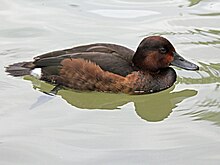Aythya nyroca
| Ferruginous duck | |
|---|---|
 |
|
| Male | |
 |
|
| Female | |
| Scientific classification | |
| Kingdom: | Animalia |
| Phylum: | Chordata |
| Class: | Aves |
| Order: | Anseriformes |
| Family: | Anatidae |
| Subfamily: | Aythyinae |
| Genus: | Aythya |
| Species: | A. nyroca |
| Binomial name | |
|
Aythya nyroca (Güldenstädt, 1770) |
|
The ferruginous duck, also ferruginous pochard, common white-eye or white-eyed pochard (Aythya nyroca) is a medium-sized diving duck from Eurasia. The scientific name is derived from Greek aithuia an unidentified seabird mentioned by authors including Hesychius and Aristotle, and nyrok, the Russian name for a duck.
The breeding male is a rich, dark chestnut on the head, breast and flanks with contrasting pure white undertail coverts. In flight the white belly and underwing patch are visible. The females are duller and browner than the males. The male has a yellow eye and the females have a dark eye.
The ferruginous duck prefers quite shallow fresh waterbodies with rich submerged and floating vegetation with dense stands of emergent vegetation on the margins. In some areas it will use saline or brackish pools or wetlands. On passage and wintering will also frequent coastal waters, inland seas and large, open lagoons.
The breeding range of the ferruginous duck is from Iberia and the Maghreb east to western Mongolia, south to Arabia, although in the west is now scarce and localised and locally extirpated in some countries. The duck winters throughout the Mediterranean Basin and the Black Sea, smaller number migrate into sub-Saharan Africa via the Nile Valley. Eastern birds winter in south and south-east Asia.
These are gregarious birds, but less social than other Aythya species but where common it can form large flocks in winter, often mixed with other diving ducks, such as tufted ducks and common pochards. Forms pairs from January onwards and during courtship the male often curls his tail so that it dips into the water forming a triangular white patch of the undertail coverts. In areas where it is common it will form colonies at protected sites such as islands, often in association with gulls. Where scarce it nests singly, in dispersed and concealed sites.
Eggs are laid from the end of April or early May in a nest which is sited on the ground close to water, or sometimes a floating nest is built among emergent vegetation. The eggs are incubated for 25–27 days and the fledging period is 55–60 days.
...
Wikipedia

